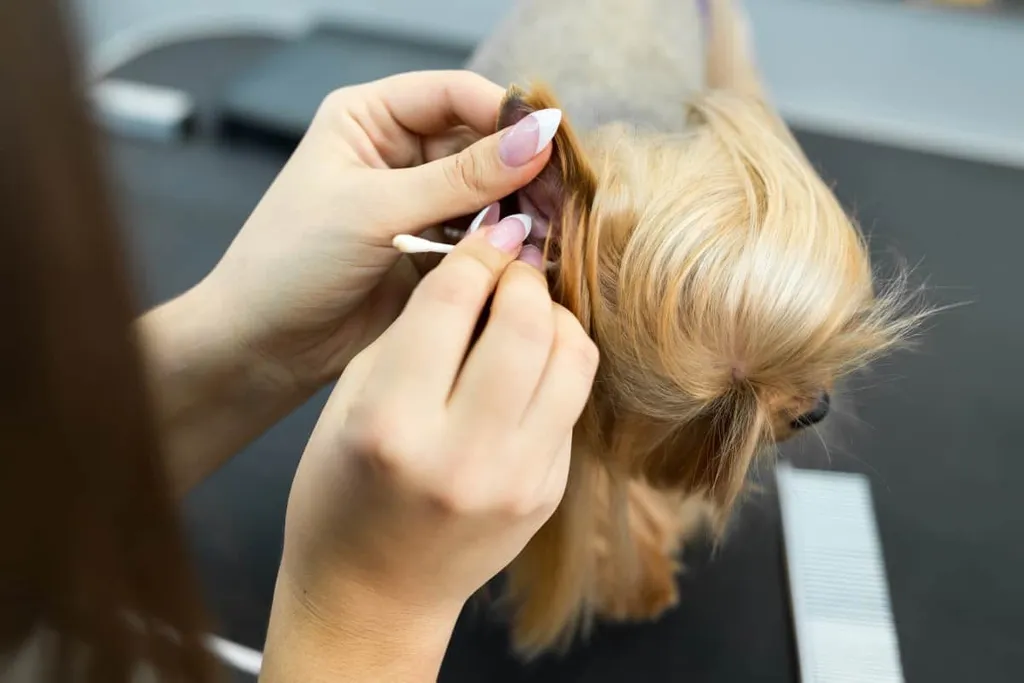Keeping your dog’s ears clean is one of the necessary parts of their overall well-being. However, cleaning those ears can be challenging if you do not know the proper methods.

There are some things you should know before cleaning your dog’s ears. Dogs’ ears can get dirty and smelly quickly. So, it is necessary to clean them regularly to avoid infection and other problems. However, many people do not know how to do it properly and end up hurting their four-legged friends. You should know what a clean, healthy ear looks and smells like, and should regularly check your dog’s ears after bathing.
Mark the Calendars: How Often Should You Clean Your Dog’s Ears?
The question is: whether to clean or not to clean your dog’s ears.
Cleaning your dog’s ears once a month is a healthy practice to follow in general. Germs and debris can fester if cleanings are not done frequently enough, leading to redness and infection. On the other hand, too many cleanings, especially when not required, might remove too much ear wax from your dog’s ears which causes irritation. You should remember that ear wax is a protective layer that does not need to be removed.
To find the perfect ear-cleaning schedule for you and your pup, below are some signs to look out for.
Sensory Signs: The Different Types of Ear Infections
Let’s start with the traits of a healthy dog ear: pink, dirt-free, odorless, and free of irritation. Cleanings once a month will usually keep their ears in perfect health. If there are any significant changes, it’s perhaps time to switch things up.
If you notice discharge and redness around the inner ears, it’s a sign that you should clean your dog’s ears more frequently. Funky odors increased scratching, and head shaking are all symptoms of an infection in your pet’s ear that needs to be treated. If you notice your dog scratching ear to ear, it’s time to reconsider carefully. In addition, active dogs, puppies, and dogs living in humid weather generally require more frequent washes.
Breed Matters: Do All Dogs Need To Have Their Ears Cleaned?
You would not feed a Great Dane the same as a Chihuahua, right? Like all dog care, ear cleaning is breed-specific. Some breeds require more ear care than others, whether due to ear shape or other genetic factors.
A few of those breeds include:
- Labrador Retrievers
- Afghan Hounds
- Shar-Peis
- Cocker Spaniels
- Pit Bulls
- Poodles
Following are the techniques that can help you remain on top of any dog’s ear care needs even with more infection-prone diseases.

The Right Tools: What Kinds of Material Can You Use to Clean Your Dog’s Ear?
Cleaning dog ears requires medically-informed types of equipment. Here’s a toolkit if you are not sure what makes a good dog ear cleaner:
- Cotton Balls: Cotton balls are soft, non-irritating material that is ideal for regular ear cleaning. One of the most used ways to clean your dog’s ears is to use a cotton ball or tissue. Gently clean away any discharge or debris around your dog’s ear cartilage with a tissue or cotton ball. Be thorough! Do not press them in your ears or use them as you would use a Q-tip. Cotton swabs, however, are the last thing you should use on your dog as this can risk damaging the ear canal.
- Cleanser: It’s all about choosing the right cleanser. Choose a mild cleaning solution that kills germs and can cure ailments such as swimmer’s ears or mites to cover all of your bases.
- Tweezers or Scissors: Spaniel owners know very well how hairy it can be going around your dog’s ears. You’ll have to trim that ear fur to get a clear path for cleaning. Tweezers are suitable for tiny, tricky regions, while round-tip scissors can be used to cut out larger clumps.
- Say Thank You: After cleaning, a small snack is much more than just a “thank you” to your pet. In this way, you will also teach them that cleaning their ears is a fun (or at least tolerable) exercise.
Refine Your Technique: What Other Ways Can You Prevent a Dog Ear Infection?
Even if you have the best equipment and tools in the world, if you don’t use them correctly, you can wind up doing more harm than good.
When cleaning your ears, the best way is to begin gently, then gradually become gentler, and ultimately finish with the gentlest. Simply said, you won’t have to be forceful with your dog’s ears.
Here are the necessary steps for the finest home ear-cleaning routine:
Understand the Anatomy of a Dog’s Ears
Learn about the inner workings of these organs before going on an ear-cleaning trip with your dog.
Like other organs of the body, the deeper you go into your dog’s ears, the risk of causing more damage and pain increases. That’s why a gentle touch is necessary for cleaning.
Following are the leading dog ear parts you should know:
- Inner Ear: The inner ear controls your dog’s hearing and balances with the vestibular system, spiral-shaped cochlea, and other sensory nerves. This area is most likely inaccessible. However, a dangerous infection can develop if the inner ear is not cleaned or cared for properly.
- Middle Ear: Consider the middle ear to be the bridge between the inner and outer ear. The eardrum and the three ear bones (anvil, hammer, and stirrup), are housed here. Cleaning too aggressively can cause permanent eardrum damage (a primary reason for the no Q-tips rule).
- Outer Ear: You know the flexible part of your dog’s ear that you like to massage behind? That’s the pinna, and its structure has everything to do with your puppy’s remarkable hearing. And the ear canal, which runs straight down to the eardrum, is located just beneath the surface. This is where you’ll discover the majority of wax, debris, and the dog’s ear discharge.
Reminder: Ear wax is not harmful in itself; in fact, it’s beneficial to have!

Follow a Step-by-Step Guide
Breaking down the process into parts can help you become the ear-cleaning dog whisperer you were meant to be. For proper and effective cleaning, try this procedure with each ear:
- Position: For puppies, place your pet comfortably on your lap. For older dogs, position them besides you, preferably seated or lying down.
- Calm and Soothe: Make sure your dog is comfortable with a petting session and short massage. In this way, cleaning your dog’s ears will be much easier and safer.
- Expose: Here, you’ll need clips or a cleaning buddy. If your dog’s ears are floppy, pin or hold the flap up to expose the cartilage and earhole. You can also trim extra hair if needed.
- Apply Cleaning Solution: Pour the cleaning solution into your dog’s ear canal slowly (be prepared for some head shaking). Massage the base of the ear for about 30 seconds, making sure the wash gets to the bottom.
- Wipe Away: Wipe away any debris or discharge from the revealed cartilage with cotton. Avoid pushing too deeply; otherwise, you risk pushing dirt farther into the ear and possibly causing harm.
- Dry Off: Use a soft towel to remove any remaining solution.
- Administer Medicine: If you’re currently treating an ear infection, now is the time to give the treatment. To avoid spreading germs, avoid touching the bottle against your dog’s actual ear.
- Give Them a Treat: Say thanks and reward your pets with a treat for their patience and affection. This will make the process a little easier the next time.
Other Infections
It’s all about preventing infections when it comes to ear cleaning. But, sad to say, life happens. Ear disorders in dogs are extremely prevalent, affecting around 20% of all puppies.
Here are some common types of ear infections or medical conditions to look out for before any future vet visit:
- Creepy Critters: Technically, these bugs are visible. They’re so small, though, that an inexperienced eye may easily miss them. If you observe excessive head shaking and scratching as well as sticky dark brown or black discharge in your dog’s ears, mites may be the culprit.
- Outer Ear Infections: Reddish or waxy yellow discharge, irritation, inflammation, and a pungent odor indicate an outer ear infection. Contact your veterinarian right away if you experience these symptoms because they could be caused by anything from bacteria to yeast.
- Inner or Middle Ear Infections: Is the puppy abruptly collapsing or going in circles? Inner and middle ear infections, like outer ear disorders, cause drainage and redness. Changes in balance and nausea levels, on the other hand, are distinct signs of internal ear disorders. Here, a veterinarian consultation is required immediately.
- Allergies: Allergies, a catch-all for inflammatory disorders, are a prevalent cause of dog ear infections. Choose a vet-approved allergy medicine for your dog to stay ahead of any seasonal allergies or hazards.
- Tumors: Although unlikely, it is possible. Ear canal tumors are more frequent in some breeds, such as German shepherds and cocker spaniels. Ask your vet to check for any growing bodies in your dog’s ears if they have repeated ear infections.
Healthy Ears, Happy Pups
Take a deep breath if you’re worried about perhaps harming your beloved Fido in the name of hygiene.
If you follow this guideline, you’ll have everything you need to clean a dog’s ears safely. Do you hear that? That’s the sound of happy pups and healthy ears.






